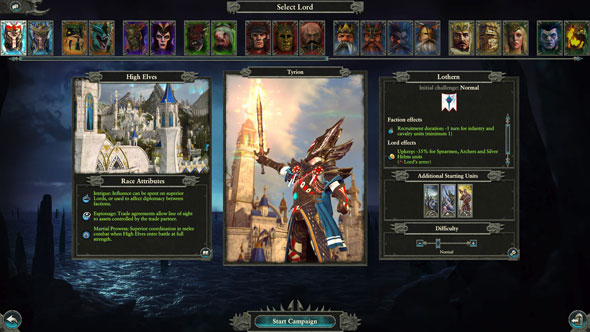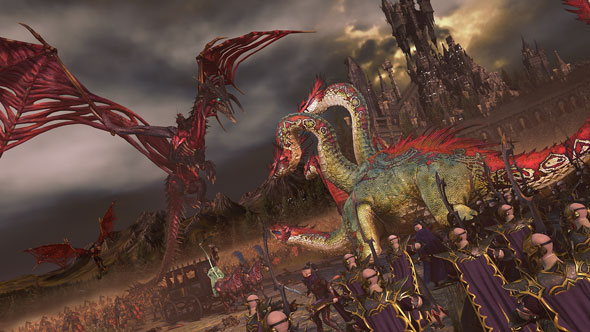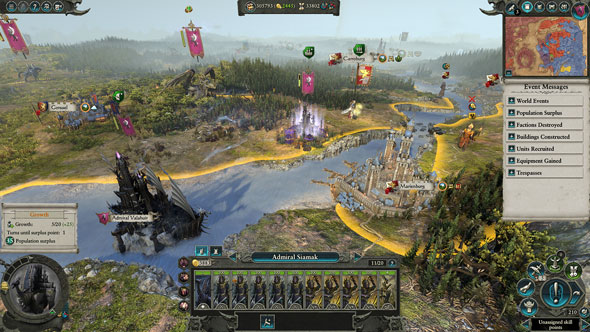
For most builders, releasing a sequel would normally mark the tip of labor on the unique sport as they transfer onto DLC, patching, and performing common upkeep for his or her new child. But for Total War: Warhammer builders Creative Assembly, the work by no means stops, as they’ve set themselves the duty of merging the marketing campaign maps of all three video games on this eventual trilogy.
As properly as speaking to Creative Assembly about Mortal Empires we have played it and can tell you what we think of this huge, free DLC.
The first step on this uncharted path is Mortal Empires, a free DLC out this week that fuses the Old World from Total War: Warhammer with the sequel’s New World into one huge sandbox, that includes 117 factions and 35 playable Lords from each video games. We spoke with sport director Ian Roxburgh and lead designer Jim Whitson concerning the formidable Mortal Empires DLC and the continued work of constructing the Total War: Warhammer world.
During our chat, there was a number of cheery, exasperated head-slapping concerning the scale of the endeavour, primarily concerning the difficulties of creating all of it play good with Steam’s API (sophisticated by the truth that this Warhammer II DLC requires the participant to additionally personal the earlier sport), and the numerous columns and rows of dry spreadsheet work to make all of it come collectively. When it comes to truly designing Mortal Empires, nonetheless, the pair are extra stoic, speaking about it as simply one other obligatory step of their quest to create the last word videogame tribute to the Warhammer world.

From a participant’s perspective, Mortal Empires nearly has the hallmarks of a fan challenge, within the vein of how modders fuse collectively the worlds of Skyrim and Oblivion, or Fallout three and New Vegas, however for Creative Assembly the inspiration stems from Warhammer lore.
“Just look at the scale of the content,” Whitson says. “When we sat down to talk about making the game, we had 15 army books – big thick tomes – and immediately said, ‘We can’t do justice to this in the context of one game, so what’s the strategy that will allow us to deliver the fidelity and quality everyone expects from a Total War game, and the Warhammer universe?’”
For all of the Warhammer-licensed video games through the years, none till now have managed to seize that fundamental tenet of the tabletop sport – pitching two vastly completely different fantasy armies towards one another, and utilizing their idiosyncrasies and asymmetries to beat the enemy. “The fans need this amalgamation of content,” Roxburgh says. “It wouldn’t be complete if you couldn’t get Skaven vs Empire in a campaign game, for example, but there’s no way we could have done that in one game.”

Fusing two video games could sound just like the videogame equal of genetic splicing, however each military throughout the 2 video games has been designed below the belief that they might ultimately meet. Even the mechanics distinctive to Total War II factions – similar to Rites – have been meticulously designed to coexist in a single huge war-torn world with the Old World content material.
“We’d already put in massive new systems for the series even before we’d released Warhammer 1, so we were prepared for this,” Roxburgh says. He describes Warhammer II’s Rites, which grant momentary faction-specific bonuses on a cooldown timer, as “flavour features,” which won’t unbalance the sport towards Old World factions. He does, nonetheless, admit that they current their very own challenges. “Since we released Warhammer II, a lot of people have called for Rites to be added to the Old World factions in Mortal Empires,” Roxburgh says. “But if you give everyone Rites, you start making these unique factions feel quite samey.”
What makes Warhammer stand out from previous Total War video games, and align with its tabletop counterpart, is that it thrives in a level of imbalance – in how the Skaven use the Underway and inhabit ruins to ambush bodily superior enemies, or in how Vampire Counts elevate the struggle lifeless to struggle for them. Share too many traits among the many factions and “it would just become one big generic war game,” in accordance with Whitson. He does, nonetheless, concede that if the followers make sufficient noise about granting Old World factions Rites, then they may think about including it. “We want to accommodate what people like,” he says.

Every Old World faction making the expedition over to Mortal Empires is retaining the identical skills, models, and traits it had earlier than, so it’s tempting to see the DLC as one thing of a migration, the place the Dwarves, Vampire Counts, Beastmen and co. are being rehoused within the consolation of Warhammer II’s polished interfaces and new marketing campaign methods that by and huge enhance on the unique. So has the unique sport, a mere couple of months after the launch of its final DLC, already been rendered out of date? Roxburgh insists that “the Warhammer 1 campaign stands as an interesting game in its own right,” however admits that the Mortal Empires marketing campaign has extra refinements, content material, polish, and UI enhancements.
Roxburgh turns my focus as a substitute to the Warhammer II Vortex marketing campaign which, with its extra distinctive mechanics and narrative, he hopes will compel gamers to return to it again and again even as soon as Warhammer III rolls round. “The Vortex is something we won’t replicate or do again,” he says. “This means that in Warhammer III, people may play the complete massive combined map [which will eventually include the third game’s campaign map and races as well], the new campaign for that game, or they might go ‘You know what? I want to go back and play the Vortex campaign’. I love the idea that players will have these choices.”
Looked at historically, the primary Total War: Warhammer could be the collection entry that’s doomed to be buried by historical past – a prototype whose potential would solely be unleashed in its superior sequels. But this isn’t a conventional trilogy. For Creative Assembly, this challenge is one tireless continuity, with the formidable objective of capturing the spirit of boundless fantasy warfare that the IP is famend for. Mortal Empires will ultimately turn out to be the brand new Ground Zero for merging with the following sport’s marketing campaign map, and within the meantime will likely be morphed and up to date to accommodate new factions and shake up the previous ones. “Empire in Mortal Empires currently start in the same place as they did in Warhammer 1, for example, but then we’ll start giving them new starting positions and all that kind of stuff,” Roxburgh says. “It’s such a massive undertaking that we couldn’t do all those things and create the map. People would be waiting months and months.”

Whitson believes that making Mortal Empires has allowed Creative Assembly to confront and banish a few of its design demons from earlier Total War video games. “Traditionally we’ve been good at short and medium-term challenges – go destroy that city, wipe out that race – but we’ve perhaps not been so good at the long-term goals,” Whitson admits. There isn’t any strict order wherein you have to full the marketing campaign victory circumstances in Mortal Empires, however they’re designed to make you give attention to the shorter-term targets first, earlier than shifting onto the larger image.
“The new long-term victory conditions [owning ‘x’ number of settlements from a list] won’t be relevant to you when you start a campaign,” Whitson continues. “Only as you tick off those shorter-term victory conditions, then you’ll start thinking ‘I need to go to Ulthuan, I need to go to Lustria’. We haven’t done that before, and it’s fun to have these different goals in different timeframes, trying to keep each plate spinning”.
Words like ‘Trilogy’ and ‘DLC’ are readily thrown round with this collection (comprehensible, provided that there are three video games, and a number of DLC), however they don’t fairly encapsulate it, fragmenting what’s actually a seamless growth course of. As a complete, Total War: Warhammer is a gestalt of increasing mechanics, maps, interfaces, and methods that’s solely at its midway stage of evolution. So spare a thought for Creative Assembly, as a result of regardless that Mortal Empires has simply inflated the Total War: Warhammer world to unprecedented proportions, their work on the collection goes ever on.
Source


